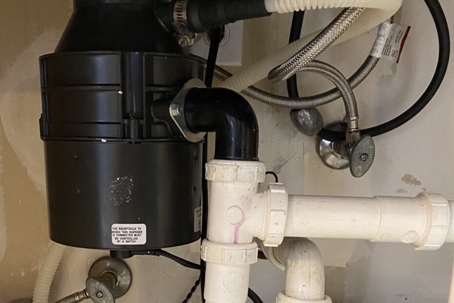Our Definitive Guide to Fixing a Leaky Waste Disposal Unit
Our Definitive Guide to Fixing a Leaky Waste Disposal Unit
Blog Article
What are your opinions on Why Is ?

Waste disposal unit are necessary kitchen devices that help in dealing with food waste successfully. However, a dripping waste disposal unit can be an aggravating and unpleasant issue to manage. Thankfully, several leakages can be fixed quickly with a few straightforward steps. In this short article, we will talk about just how to repair a dripping waste disposal unit successfully.
Intro
Garbage disposals are mounted under kitchen sinks and are made to shred food waste right into smaller items, enabling it to go through the pipes system easily. While these devices are typically trustworthy, leakages can occur gradually due to deterioration, loosened connections, or damages to the unit.
Step-by-Step Overview to Repairing a Dripping Waste Disposal Unit
Switch off the Power
Prior to trying any repair work, ensure that the power to the waste disposal unit unit is turned off to avoid the threat of electric shock.
Find the Leakage
Identify the specific place of the leak and determine the reason
Tighten Links
Utilize a wrench to tighten up any loose connections in between the disposal unit and the pipes system.
Change Seals or Gaskets
If the leakage results from used seals or gaskets, eliminate the old elements and change them with brand-new ones.
Patching Cracks or Holes
For cracks or holes in the disposal device, usage epoxy or an appropriate patching product to seal the broken location.
Recognizing the Source of the Leakage
Prior to trying to take care of a dripping garbage disposal, it is essential to determine the source of the leakage. This can commonly be done with visual inspection or by performing simple examinations.
Visual Examination
Check the garbage disposal system thoroughly for any signs of water leak. Pay attention to areas around seals, gaskets, and connection factors.
Examining for Leaks
One means to examine for leakages is by running water via the disposal system and looking for any kind of visible signs of leakage.
Usual Causes of Leaks in Rubbish Disposals
Worn Seals and Gaskets
Seals and gaskets play an important duty in preventing water from dripping out of the waste disposal unit. Over time, these parts can weaken, causing leaks around the disposal device.
Loose Connections
The links in between the waste disposal unit and the pipes system can end up being loosened over time, triggering water to leakage out during operation.
Fractures or Openings in the Disposal Device
Physical damage to the garbage disposal, such as fractures or holes in the housing, can likewise lead to leakages.
Tools and Products Needed for Dealing With a Dripping Waste Disposal Unit
Prior to beginning the repair procedure, gather the needed tools and materials, including a screwdriver, flexible wrench, plumber's putty, substitute seals or gaskets, and epoxy or patching material for repairing cracks or holes.
Checking the Waste Disposal Unit After Fixing
When the repair work is complete, test the waste disposal unit by running water with it to ensure that the leakage has actually been resolved.
Preventive Upkeep Tips to Avoid Future Leaks
To avoid future leakages, it is important to execute routine upkeep on your waste disposal unit. This consists of maintaining it clean, staying clear of putting non-food things or hard things down the disposal, and occasionally looking for leakages or other problems.
Final thought
To conclude, taking care of a leaking garbage disposal is a reasonably simple process that can be completed with standard devices and materials. By complying with the steps detailed in this write-up and exercising precautionary maintenance, you can maintain your garbage disposal in good working problem and stay clear of pricey fixings in the future.
HERE’S HOW TO FIX YOUR GARBAGE DISPOSAL
WHAT TO DO IF SOMETHING IS STUCK IN YOUR GARBAGE DISPOSAL
If the impeller won’t turn, there’s probably something stuck in the disposal. It could be a steak bone or peach pit, although plumbers report pulling all sorts of inappropriate objects out of disposals, such as bottle caps or aluminum foil. Make sure power to the disposal is off, and look inside to see if you can see the source of the jam.
Never stick your fingers in a disposal. Pull out anything you see with tongs or pliers.
If the disposal still won’t work, it may be time to call a plumber or consider buying a new disposal. GEM Plumbing & Heating is here for all of your garbage disposal needs.
WHAT TO DO IF YOUR GARBAGE DISPOSAL DRAIN IS CLOGGED
Take everything out from underneath your sink and put a bucket or other container under your disposal to catch any water that drains out. Disconnect your disposal from the power supply. If it’s plugged into a wall outlet, unplug it. If it’s hardwired into an electrical box, go to the electrical panel and turn off the breaker for the disposal. Pour ¼ cup of baking soda into the drain, followed by ½ cup of white vinegar. Give the solution a few minutes to fizz and do its work. Look into the disposal with a flashlight to see if you can see an object that might be causing the clog. If you see it, remove it using tongs or pliers. MORE TIPS ON DEALING WITH A CLOGGED GARBAGE DISPOSAL
Never use drain cleaner in a garbage disposal. It can damage the plastic parts inside the disposal. You can also be splashed with the caustic liquid while working to clear the clog. Beware! Never stick your fingers into a garbage disposal. Trust us — not a good idea. In many instances, your dishwasher drains through your garbage disposal. This allows the disposal to grind any large food particles that may be drained out of your dishwasher. There are some jurisdictions, however, where the plumbing code prohibits such a connection. WHAT TO DO WHEN YOUR DISHWASHER DRAINS THROUGH THE DISPOSAL
Run some water in the sink so your plunger has at least a ½-inch of water to create a seal and plunge vigorously up and down several times. You may need to repeat this several times. Run hot water down the drain to clear any residue that remains.

We were introduced to that editorial about Why Is from someone on our other web address. Do you know about someone else who is intrigued by the topic? Please feel free to share it. Kudos for your time. Come back soon.
Quote & Schedule Report this page